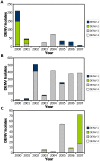Arboviral etiologies of acute febrile illnesses in Western South America, 2000-2007
- PMID: 20706628
- PMCID: PMC2919378
- DOI: 10.1371/journal.pntd.0000787
Arboviral etiologies of acute febrile illnesses in Western South America, 2000-2007
Abstract
Background: Arthropod-borne viruses (arboviruses) are among the most common agents of human febrile illness worldwide and the most important emerging pathogens, causing multiple notable epidemics of human disease over recent decades. Despite the public health relevance, little is know about the geographic distribution, relative impact, and risk factors for arbovirus infection in many regions of the world. Our objectives were to describe the arboviruses associated with acute undifferentiated febrile illness in participating clinics in four countries in South America and to provide detailed epidemiological analysis of arbovirus infection in Iquitos, Peru, where more extensive monitoring was conducted.
Methodology/findings: A clinic-based syndromic surveillance system was implemented in 13 locations in Ecuador, Peru, Bolivia, and Paraguay. Serum samples and demographic information were collected from febrile participants reporting to local health clinics or hospitals. Acute-phase sera were tested for viral infection by immunofluorescence assay or RT-PCR, while acute- and convalescent-phase sera were tested for pathogen-specific IgM by ELISA. Between May 2000 and December 2007, 20,880 participants were included in the study, with evidence for recent arbovirus infection detected for 6,793 (32.5%). Dengue viruses (Flavivirus) were the most common arbovirus infections, totaling 26.0% of febrile episodes, with DENV-3 as the most common serotype. Alphavirus (Venezuelan equine encephalitis virus [VEEV] and Mayaro virus [MAYV]) and Orthobunyavirus (Oropouche virus [OROV], Group C viruses, and Guaroa virus) infections were both observed in approximately 3% of febrile episodes. In Iquitos, risk factors for VEEV and MAYV infection included being male and reporting to a rural (vs urban) clinic. In contrast, OROV infection was similar between sexes and type of clinic.
Conclusions/significance: Our data provide a better understanding of the geographic range of arboviruses in South America and highlight the diversity of pathogens in circulation. These arboviruses are currently significant causes of human illness in endemic regions but also have potential for further expansion. Our data provide a basis for analyzing changes in their ecology and epidemiology.
Conflict of interest statement
The authors have declared that no competing interests exist.
Figures



References
-
- Gubler DJ. The global resurgence of arboviral diseases. Trans R Soc Trop Med Hyg. 1996;90:449–451. - PubMed
-
- Mackenzie JS, Gubler DJ, Petersen LR. Emerging flaviviruses: the spread and resurgence of Japanese encephalitis, West Nile and dengue viruses. Nat Med. 2004;10:S98–109. - PubMed
-
- Yuill TM. The ecology of tropical arthropod-borne viruses. Ann Rev Ecol Syst. 1986;17:189–219.
-
- Bharti AR, Nally JE, Ricaldi JN, Matthias MA, Diaz MM, et al. Leptospirosis: a zoonotic disease of global importance. Lancet Infect Dis. 2003;3:757–771. - PubMed
Publication types
MeSH terms
Substances
LinkOut - more resources
Full Text Sources
Other Literature Sources

